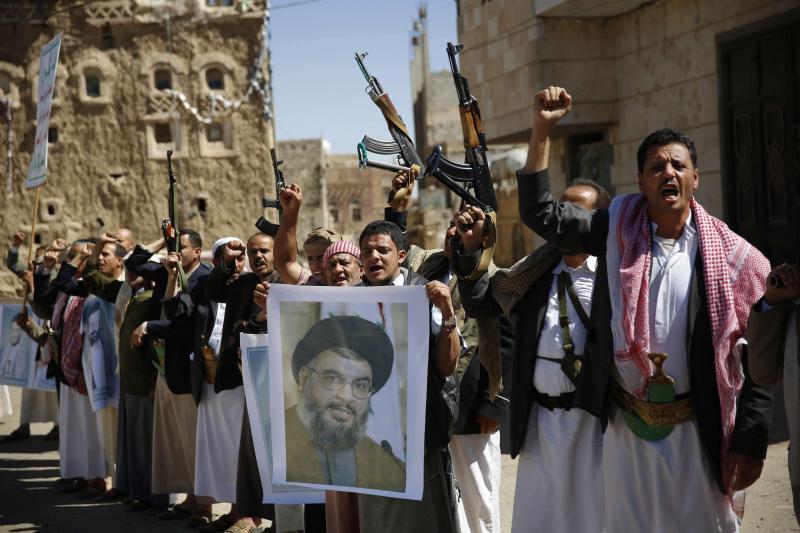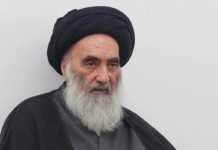Hezbollah’s covert agenda in Yemen comes to the open
الأجندة الإيرانية الخفية في اليمن تظهر إلى العلن
Iman Zayat/The Arab Weekly/July 02/18
Hezbollah’s Unit 3800, modelled on al-Quds Force, counts highly skilled operatives sworn to uphold the Iranian regime’s expansionist project.
TUNIS – Lebanon’s Shia Hezbollah movement and the Iran-backed Houthi rebels are developing closer ties, reports say, fuelling sectarian divides and driving instability in the region.
The Arab coalition fighting the Iran-aligned Houthis in Yemen said on June 25 that their allies killed eight Hezbollah fighters in battles in the mountainous Saada region in north-western Yemen. Coalition spokesman Colonel Turki al-Maliki said the Hezbollah fighters were part of a group heading to the Saudi border when they were spotted.
“Terrorist members… from Hezbollah and from the Iranian regime are coming to help the rebels launch ballistic missiles and train them in combat,” he said. “Both Iran and… Hezbollah must stop sending military experts to Yemen.”
The statement, which came as Yemeni pro-government forces were locked in heavy battles with Houthi rebels to take the key aid hub of Hodeidah, pointed to a growing Hezbollah presence in the country but was not the first indication of its activities there.
Hezbollah and the Iranian al-Quds Force have long coordinated operations in Yemen. Hezbollah has provided funds and training to Houthi fighters and al-Quds Force oversaw the transfer of advanced weaponry, such as anti-aircraft missiles.
In addition, Iran has long been accused of providing the Houthis with ballistic missiles that have been launched at Saudi Arabia and, last November, Saudi Foreign Minister Adel al-Jubeir told CNN that Hezbollah fired a missile provided by Iran at the kingdom from Yemeni territory.
An early indication of Iran’s activities in Yemen came in 2009 when former Yemeni President Ali Abdullah Saleh appeared on Al Jazeera accusing Tehran of providing financial and military support to the Houthi rebels. In 2014, news of direct Hezbollah involvement in Yemen broke when some of its operatives were arrested in Yemen and charged with training Houthi rebels. Those men were connected to Hezbollah’s Unit 3800, which was first tasked with training Shia militants in Iraq.
In mid-2015, Hezbollah was again revealed to be active in Yemen when Saudi Arabia sanctioned senior Hezbollah members Khalil Harb and Muhammad Qabalan for “terrorist actions.”
Saudi Arabia accused Harb of commanding Hezbollah’s “central military unit” and of being responsible for the group’s activities in Yemen. It pointed to Qabalan’s role in terrorist activities in Egypt and accused him of “spreading chaos and instability.”
Harb, who took charge of Unit 3800 in 2012, “was responsible for Hezbollah’s Yemen activities and was involved in the political side of Hezbollah’s Yemen portfolio,” a 2013 statement by the US Treasury Department claimed.
That summer, Harb was involved in moving “large amounts of currency to Yemen, through Saudi Arabia and the UAE” and, in late 2012, “Harb advised the leader of a Yemeni political party that the party’s monthly Hezbollah funding of $50,000 was ready for pick up,” the statement said.
Hezbollah’s Unit 3800, modelled on al-Quds Force, counts highly skilled operatives sworn to uphold the Iranian regime’s expansionist project. Their Yemen activities have been key in helping the Houthis gain control of much of northern Yemen, including Sana’a, and improving their military capabilities. Hezbollah’s involvement is also believed to have helped entrench the Iranian presence in Yemen.
Head of the US Central Command, US Army General Joseph Votel, warned the US Congress in February that Iran “is attempting to do in five years with the Houthis in Yemen” what it took “20 years (to do) with Hezbollah in Lebanon.”
Votel’s warning signalled growing concern in the United States that a new Hezbollah could be born in Yemen, further imperilling regional security and giving Iran more leverage.
While Hezbollah and the Houthis are both considered Iranian proxies, Hezbollah, with more than 30 years of experience, has proven far more aggressive and effective. Its involvement in the Syrian civil war has seen it transformed from a localised resistance force to one of the most significant powers within the region. The Houthis, on the other hand, have displayed less discipline and skill.
What the two groups share, however, is political ambition and devotion to the Iranian cause.
Hezbollah’s political ambition is clearest in Lebanon, where it is perceived as a legitimate political actor and secured a strong presence in the government. Hezbollah’s foreign policy objectives, which include training and arming Shia fighters across the region, have cast such legitimacy into question.
As for the Houthis, their political ambition took the form of a bloody coup that plunged Yemen into a cycle of violence and chaos that has yet to end. In 2015, the Arab coalition intervened in Yemen to restore the country’s internationally recognised government and thwart what it sees as Iran’s expansionist ambitions.
With the Arab coalition intensifying its campaign to dislodge the Houthis from the strategic port city of Hodeidah, thus severing their supply line to Sana’a, the Hezbollah-Houthi covert connection appears to be coming into the open.
Tangible proof of Hezbollah’s direct involvement in Yemen would put the Shia group in a tough spot. Being seen as a Shia expeditionary force fighting at Iran’s behest could cause Hezbollah to lose respect from its fighters and see its popularity decrease at home and abroad. Hezbollah’s regional forays also threaten to put Lebanon at risk of Arab economic sanctions.
Whether Saudi Arabia and other Arab countries can formulate a comprehensive strategy to contain Hezbollah’s increased operational tempo in the region remains to be seen. So far, disjointed and incoherent efforts are proving insufficient.
*Iman Zayat is the Managing Editor of The Arab Weekly.
https://thearabweekly.com/hezbollahs-covert-agenda-yemen-comes-open






















